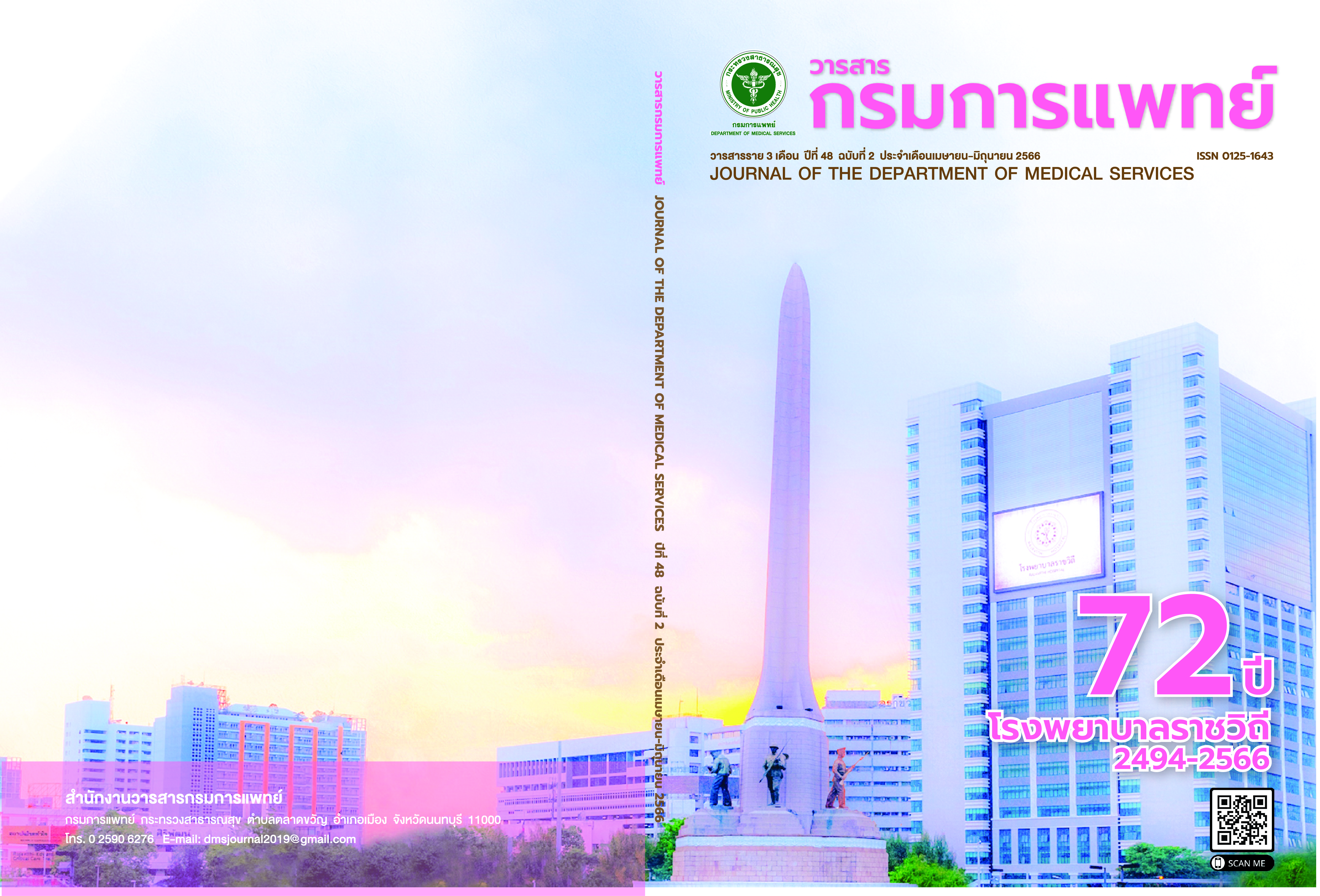Melasma: A Review of Current Treatments
DOI:
https://doi.org/10.14456/jdms.2023.34Keywords:
Melasma, Pigmentary disorders, Hyperpigmentation, TreatmentAbstract
Melasma is a commonly acquired hyperpigmented skin disorder of uncertain etiology. Several predisposing factors, such as UV radiation, genetic predisposition, dark skin, and female sex hormones, can induce melasma. However, its exact pathogenesis is complex and involves melanocyte function, including interactions between keratinocytes and melanocytes as well as gene regulation abnormalities. Topical therapy remains a mainstay treatment for melasma, and oral medications were helpful in appropriate cases. Procedural approaches, such as laser therapy and chemical peeling, have been proven to be beneficial in most cases. Several recent studies have also suggested new cutting-edge modalities for possible successful treatment, for example, picosecond laser. Besides, this review provides a comprehensive update in the pathogenesis and systematic treatment of melasma (Table 1).
References
Deshpande SS, Khatu SS, Pardeshi GS, Gokhale NR. Crosssectional study of psychiatric morbidity in patients with melasma.Indian J Psychiatry 2018; 60(3):324–28.
Kim EJ, Park HY, Yaar M, Gilchrest BA. Modulation of vascularendothelial growth factor receptors in melanocytes. ExpDermatol 2005; 14(8):625-33.
Alexis AF, Blackcloud P. Natural ingredients for darker skin types:growing options for hyperpigmentation. J Drugs Dermatol. 2013;12(9 sappl):s123-7.
Mazurek K, Pierzchała E. Comparison of effcacy of productscontaining azelaic acid in melasma treatment. J CosmetDermatol 2016; 15(3):269-82.
Schulte BC, Wu W, Rosen T. Azelaic Acid: Evidence-basedUpdate on Mechanism of Action and Clinical Application.J Drugs Dermatol 2015; 14(9):964-8.
Zhong SM, Sun N, Liu HX, Niu YQ, Wu Y. Reduction of facialpigmentation of melasma by topical lignin peroxidase: A novelfast-acting skin-lightening agent. Exp Ther Med 2015; 9(2):341-4.
Amer M, Metwalli M. Topical liquiritin improves melasma.Int J Dermatol 2000; 39(4):299-301.
Del Rosario E, Florez-Pollack S, Zapata L Jr, Hernandez K,Tovar-Garza A, Rodrigues M, et al. Randomized, placebocontrolled, double-blind study of oral tranexamic acid in thetreatment of moderate-to-severe melasma. J Am Acad Dermatol.2018; 78(2):363-9.
Sonthalia S, Jha AK, Lallas A, Jain G, Jakhar D. Glutathione for skinlightening: a regnant myth or evidence-based verity? DermatolPract Concept 2018; 8(1):15-21.
Cassiano DP, Espósito ACC, da Silva CN, Lima PB, Dias JAF,Hassun K, et al. Update on Melasma-Part II: Treatment. DermatolTher (Heidelb) 2022; 12(9):1989–2012.
Nestor M, Bucay V, Callender V, Cohen JL, Sadick N, Waldorf H.Polypodium leucotomos as an Adjunct Treatment of PigmentaryDisorders. J Clin Aesthet Dermatol 2014; 7(3):13-7.
Choudhry SZ, Bhatia N, Ceilley R, Hougeir F, Lieberman R,Hamzavi I, et al. Role of oral Polypodium leucotomos extractin dermatologic diseases: a review of the literature. J DrugsDermatol 2014; 13(2):148-53.
Faghihi G, Shahingohar A, Siadat AH. Comparison between1% tretinoin peeling versus 70% glycolic acid peeling in thetreatment of female patients with melasma. J Drugs Dermatol2011; 10(12):1439-42.
Trivedi MK, Yang FC, Cho BK. A review of laser and light therapyin melasma. Int J Womens Dermatol 2017; 3(1):11-20.
Gokalp H, Akkaya AD, Oram Y. Long-term results in low-fluence1064-nm Q-Switched Nd:YAG laser for melasma: Is it effective?J Cosmet Dermatol 2016; 15(4):420-6.
Parra CAH, Careta MF, Valente NYS, de Sanches Osório NEG,Torezan LAR. Clinical and Histopathologic Assessment of FacialMelasma After Low-Fluence Q-Switched Neodymium-DopedYttrium Aluminium Garnet Laser. Dermatol Surg 2016; 42(4):507-12.
Jalaly NY, Valizadeh N, Barikbin B, Yousef M. Low-powerfractional CO2 laser versus low-fluence Q-switch 1,064 nm Nd:YAG laser for treatment of melasma: a randomized, controlled,split-face study. Am J Clin Dermatol 2014; 15(4):357-63.
Ghorbel HH, Boukari F, Fontas E, Montaudié H, Bahadoran P,Lacour JP, et al. Copper Bromide Laser vs Triple-CombinationCream for the Treatment of Melasma: A Randomized ClinicalTrial. JAMA Dermatol 2015; 151(7):791-2.
Torbeck RL, Schilling L, Khorasani H, Dover JS, Arndt KA,Saedi N. Evolution of the Picosecond Laser: A Review ofLiterature. Dermatol Surg 2019; 45(2):183-94.
Lyons AB, Moy RL, Herrmann JL. A Randomized, Controlled,Split-Face Study of the Effcacy of a Picosecond Laser in theTreatment of Melasma. J Drugs Dermatol 2019; 18(77):1104-7.
Choi YJ, Nam JH, Kim JY, Min JH, Park KY, Ko EJ, et al. Effcacyand safety of a novel picosecond laser using combination of1 064 and 595 nm on patients with melasma: A prospective,randomized, multicenter, split-face, 2% hydroquinonecream-controlled clinical trial. Lasers Surg Med 2017; 49(70):899-907.
Chalermchai T, Rummaneethorn P. Effects of a fractionalpicosecond 1,064 nm laser for the treatment of dermal andmixed type melasma. J Cosmet Laser Ther 2018; 20(3):134-9.
Spierings NMK. Melasma: A critical analysis of clinical trialsinvestigating treatment modalities published in the past 10 years.J Cosmet Dermatol 2020; 19(6):1284-9.
Sarkar R, Gokhale N, Godse K, Ailawadi P, Arya L, Sarma N,et al. Medical Management of Melasma: A Review withConsensus Recommendations by Indian Pigmentary ExpertGroup. Indian J Dermatol 2017; 62(10):558-77.
Manuskiatti W, Yan C, Gulfan MCB, Techapichetvanich T,Wanitphakdeedecha R. Combination of a 755-nm picosecondlaser and hydroquinone 2% cream versus hydroquinone 2%cream alone for the treatment of melasma: A randomized,split-face, and controlled trial. Lasers Surg Med 2022; 54(10):1245-50.
Downloads
Published
How to Cite
Issue
Section
License
Copyright (c) 2023 Department of Medical Services, Ministry of Public Health

This work is licensed under a Creative Commons Attribution-NonCommercial-NoDerivatives 4.0 International License.
บทความที่ได้รับการตีพิมพ์เป็นลิขสิทธิ์ของกรมการแพทย์ กระทรวงสาธารณสุข
ข้อความและข้อคิดเห็นต่างๆ เป็นของผู้เขียนบทความ ไม่ใช่ความเห็นของกองบรรณาธิการหรือของวารสารกรมการแพทย์



